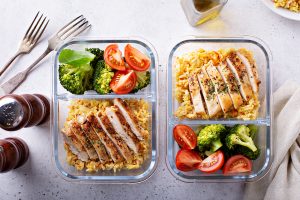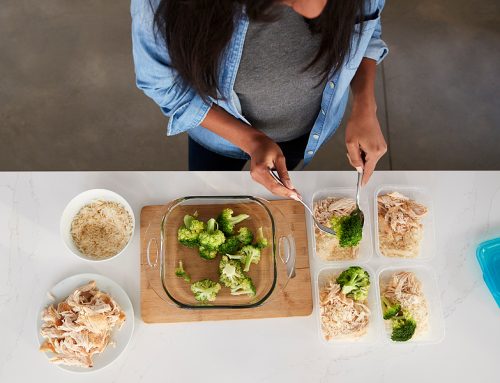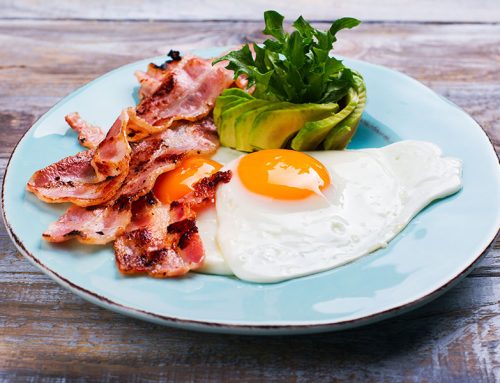The “protein-first” method is a new, alternative, and most important – ultra simple – way of setting your macronutrients, aka “macros” – protein, carbohydrate and fat – that many nutrition coaches are starting to use and embrace because it’s so simple. Having a simple method is helpful because crunching macro numbers is one of the first stages in the meal planning process where many people get confused and frustrated.
 Yes, you can still set up your meal plans using the classic method based entirely on percentages, but knowing how to choose the right percentages for your specific goals and circumstances is easier said than done and is the step where many people stumble.
Yes, you can still set up your meal plans using the classic method based entirely on percentages, but knowing how to choose the right percentages for your specific goals and circumstances is easier said than done and is the step where many people stumble.
The protein first method bypasses confusion and virtually guarantees your grams of protein, carbs and fat fall into a well-balanced and healthy range, near the ideal amounts for improving body composition. These macros will suit every healthy, active person, as long as they don’t have special or unusual needs or dietary requirements.
We are assuming that you already know how many calories you need to eat and you’ve properly calculated that number beforehand. There are only three macros, so that means there are only three steps.
Step 1: Set Protein Grams Using A Body Weight Formula (1 gram per pound of total bodyweight, or 1 gram per pound of goal bodyweight)
The root of the word protein comes from the Greek, meaning “of first importance.” That is literally true because protein intake assists with fat loss in ways that carbs and fat do not.
Protein has the highest thermic effect and is the most appetite-suppressing macro. Protein also helps you retain your lean body mass when you’re in a calorie deficit.
If you get your calories right and get your protein right, you’re actually 90% of the way there with your nutrition numbers, because those are the two biggest priorities for fat loss.
Because protein is so important, it pays to prescribe it with care and be sure about it. To set a truly customized protein goal that’s right for you, it’s ideal to set your protein target based on grams per pound of bodyweight. This way, the protein target is relative to your body size.
Bodybuilders, who are some of the leanest and muscular people on earth, have had a long-standing rule for protein intake: Eat 1 gram per pound of bodyweight.
This comes very close to what the research says, which is 0.8 to 1.0 grams per pound, while also allowing a small margin for error (better to be on the slightly too high side than the too low side when it comes to protein).
A 195 pound bodybuilder then, would eat 195 grams of protein per day.
This formula couldn’t be simpler or easier to remember. Some eat a little more protein, some eat a little less protein, but for people who lift weights and are fairly lean, this rule of thumb has stood the test of time in research and in practice. (Note: Resistance training increases protein needs and we are making the assumption that everyone using this protein formula is lifting weights).
The problem is, what if you’re not already lean, like a bodybuilder or athlete? What if you’re currently overweight? That’s a good question, because if you weigh 195 pounds but you want to weigh 145 pounds, (and you’re not a bodybuilder), do you really need 195 grams of protein? You don’t, and that’s because you don’t need additional protein to support body fat tissue.
For anyone overweight, it makes more sense to set protein based on lean body mass. Even that idea doesn’t always pan out because not everyone knows their lean body mass, and even if you do, you must be certain your body fat test was accurate because your protein goal will only be as accurate as your lean body mass calculation.
For people with weight loss goals who have high body fat or significant weight to lose, the simple alternative is to base your daily protein intake on your goal body weight. If you’re 195 pounds and you consider yourself overweight, and if your goal weight is 145 pounds, then you eat 145 grams of protein.
As you can see, the protein formulas are different for overweight people and lean people who want to get even leaner (bodybuilders, etc), but they’re both ultra simple and easy to remember.
Step 2: Set Fat Grams Using The Accepted Percentage Range (15 to 30% of total calories)
In peer-reviewed nutrition science, there’s something called the acceptable macronutrient distribution range (AMDR) and for fat, that’s anywhere between 20% and 35% of total calories.
In the fitness community, where controlling calories, cutting body fat and improving body composition are prioritizes, guidelines are similar. The most common recommendation is 15% to 30% fat. You can customize within this range based on your goals and preferences.
Some people aim for the lower end, setting 15% as their target, because they’d prefer to leave room for more carbs. Other people prefer to set their fat higher, usually because they prefer the opposite – fewer carbs and more healthy higher fat foods (avocado, nuts, nut butters, whole eggs, olive oil, and so on).
People who are brand new to macros and meal planning may not have a preference yet, so an easy place to start is in the middle with 20 or 25% of total calories from fat.
Let’s suppose a female is aiming for 1700 calories per day for weight loss and she chooses 25% of calories from fat. 25% of 1700 calories is 425 fat calories. There are 9 calories in a gram of fat, so, 425 fat calories divided by 9 calories per gram of fat is 47 grams of fat per day.
And let’s suppose our male bodybuilder weighing 195 pounds chooses 20% fat. If his calorie target is 2300 per day, 20% is 460 fat calories. Divided by 9 calories per gram of fat, that gives him 51 grams of fat per day.
That’s all there is to it, and here’s what the tally looks like so far:
Female 195 pounds, aiming to hit goal weight 145:
1700 calories
145 grams protein (580 fat calories)
47 grams fat (425 fat calories)
Male 195 pound lifter aiming to get ripped:
2300 calories
195 grams protein (780 fat calories)
51 grams fat (460 fat calories).
Step 3: Carb Grams Are Set Automatically Based On What’s Left
The last macro to set is carbs. Actually, using this new system, the carbs have already set themselves! The carbs are what’s left after protein and fat. Told you it was simple.
In our first example, we already used up 580 protein calories and 425 fat calories – a total of 1005 calories, and we only have 1700 calories to work with, If she now subtracts 1005 fat and protein calories from the 1700 calories per day target, that leaves 695 calories from carbs.
Carbs, like protein, also have 4 calories per gram, so 695 carb calories divided by 4 calories per gram is 174 grams of carbs. That’s it! All three macros are done, and the same math applies for men as women.
Here’s the final numbers:
Female 195 pounds, aiming to hit goal weight 145:
1700 calories
145 grams protein (580 fat calories)
47 grams fat (425 fat calories)
174 grams carbs (695 calories)
Male 195 pound lifter aiming to get ripped:
2300 calories
195 grams protein (780 fat calories)
51 grams fat (460 fat calories)
265 grams of carbs (1060 carb calories)
Once you know your calorie and macro targets in grams, you’re ready to create a daily meal plan that fits those numbers. (learn how here)
What about macro percentages (ratios?)
Your macros can be set up by grams, percentages or both. The classic system uses all macro percentages.
We introduced a new system here, the protein-first method, and we did that because it’s more accurate for nailing down your correct protein intake. Most of all, it’s simpler, so beginners are less likely to make mistakes in choosing the numbers.
We did use a macro percentage to help you find your fat intake, but aside from that, we’ve been talking in terms of grams not percentages. Once you have your gram numbers, if you’re still curious about what the macro ratios come out to, you can do that calculation as well:
Female 195 pounds, aiming to hit goal weight 145:
145 grams protein = 580 fat calories = 34% protein
47 grams fat = 425 fat calories = 25% fat
174 grams carbs = 695 calories = 41% carbs
Male 195 pound lifter aiming to get ripped:
195 grams protein = 780 protein calories = 34% protein
51 grams fat = 460 fat calories = 20% fat
265 grams of carbs = 1060 carb calories = 46% carbs)
For most people starting a fat loss plan, the macro targets are 30 to 35% protein (occasionally higher in strict, lower calorie diets), 20 to 30% fat and 40 to 50% carbs. Using the protein-first method, you can see in our example, that’s exactly where the macros fell.
The best part is, when you use this method, as long as you did your calorie calculations right first, your macro numbers are customized specifically for you.
What if you want more protein?
One gram per pound typically covers all bases, including a margin for error and including protein needs for training. However, there’s some evidence that protein intakes in the 1.1 to 1.3 grams per pound range can help retain lean body mass during strict low calorie diets (like prepping for physique competitions). Some people, especially bodybuilders, simply like to eat more protein as a personal preference.
Since research suggests there’s no harm or down side in going higher in protein, if you want to eat more protein, that’s your choice. Simply customize your own protein gram amount as you see fit and then follow the rest of this system as explained above. Your carbs (or fat) will simply end up a little lower to make room for those extra protein calories.
What if you want less carbs or more fat? What about low carb diets?
The most important thing to know is that carb intake and fat intake are highly customizable and hitting a specific number for carbs or fat doesn’t matter as much as it does for calories and protein.
Using the protein first system, you have quite a bit of room to personalize your carb and fat intake.
However, as I mentioned above, this is a general macro formula designed to work for most people, most of the time. This is not for people who have special needs or requirements and this system does not apply at all to people who want to follow extreme (ie, ketogenic) low carb diets.
It’s up to you if you want to customize carbs more than this system dictates. However, since reducing carbs, especially dramatically, is a form of restriction, and restrictive diets are harder for most people to follow in the long term, it makes sense for almost all beginners to start with a more balanced spread of macros, stay away from extremes on either end of the spectrum and remember that carbs don’t make you fat, excess calories do.
Research has been pouring out of universities and laboratories around the world in recent years that suggest both lower carb and higher carb diets (and everywhere in between) will work to a similar degree, provided calories and protein were set properly. It’s really not the carbs that matter for fat loss – it’s achieving a calorie deficit and adherence to your plan that matters. After covering essential nutrients, the rest is up to personal preference.
Bottom line: Using this formula for setting your macros provides a great place for most people to start. The key is to keep it simple and get started, see how you like your initial meal plan at these macros, see how you feel, gain some experience, measure your results every week or two, and then later you can decide if you want to adjust your macros a little more in one direction or the other.
– Tom Venuto, author of Burn The Fat, Feed the Muscle (BFFM)
author of BFFM Guide to Flexible Meal Planning For Fat Loss
Founder of Burn The Fat Inner Circle
PS. Want your macro calculations done in seconds? You don’t have to crunch these numbers by hand. With my free calculator, you can enter your target calories, select a couple of macro details, click a button and you’ll have your macros instantly. Click here: The Best Macro Calculator (Protein-First Method)

Tom Venuto has been a trusted natural bodybuilding and fat loss expert since 1989. He is also a recipe creator specializing in fat-burning, muscle-building cooking. Tom is a former competitive bodybuilder and today works as a full-time fitness coach, writer, blogger, and author. In his spare time, he is an avid outdoor enthusiast and backpacker. His book, Burn The Fat, Feed The Muscle is an international bestseller, first as an ebook and now as a hardcover and audiobook. The Body Fat Solution, Tom’s book about emotional eating and long-term weight maintenance, was an Oprah Magazine and Men’s Fitness Magazine pick. Tom is also the founder of Burn The Fat Inner Circle – a fitness support community with over 53,000 members worldwide since 2006. Click here for membership details
Scientific References:
Sartorius K et al, Does high carbohydrate intake lead to increased risk of obesity? A systematic review and analysis, British Medical Journal, Open, 2018
Schoeller, D, et al, Energetics of obesity and weight control: does diet composition matter? Journal of the American Dietetic Association, 105:S24-S28. 2005.
Wolfe RR, et al, Optimizing Protein Intake in Adults: Interpretation and Application of the Recommended Dietary Allowance Compared with the Acceptable Macronutrient Distribution Range, Advanced Nutrition, 8(2), 266-275, 2017.
Manore MM, Exercise and the Institute of Medicine recommendations for nutrition, Current Sports Medicine Reports, 4(4), 193-198, 2005.
Dietary Guidelines should reflect new understandings about adult protein needs. Layman, Donald. Nutrition and Metabolism, 6:12. 2009.
A systematic review of dietary protein during caloric restriction in resistance trained lean athletes: a case for higher intakes. Helms, et al. International Journal of Sports Nutrition And Exercise Metabolism. 2: 127-138, 2014.
Dietary protein for athletes: from requirements to optimum adaptation. Phillips SM1, Van Loon LJ. J Sports Sci. 2011;29 Suppl 1:S29-38.







Hi Tom,
great article as always!
I’m looking to bulk up and keep fat gain to a minimum. The above article talks to overweight people and lean people who want to get even leaner, but what about people who want to increase weight (muscle) and get leaner at the same time (the holy grail)?
Should I aim for higher protein?
I’m 172 lbs, if my goal weight is 195 lbs should I follow the male 195 pound lifter aiming to get ripped macros above?
Thanks!
Al.
Hi Al. that’s an interesting question – ie, whether the goal weight should be used in the other direction for setting protein. actually I would simply aim for 1 gram per pound of total current bodyweight and that should cover you. Fill in the rest with carbs and fat as you prefer. Then for body recomposition (holy grail) the approach currently considered ideal is to eat in a small surplus on lifting days (approx 4 days a week) with the surplus calories coming from more carbs, and eat in a small deficit on non lifting days (about 3 days/wk), but maintain the protein on those deficit days (don’t lower the protein intake). PS. also check out my gaintaining article: https://www.burnthefatinnercircle.com/public/Gaintaining-Vs-Bulking-And-Cutting.cfm
Having determined the level of carbs, one might then think about how to obtain them. Just as the protein-first approach described here starts with proteins and then leaves the balance to fats and carbs, one can think about a “fiber-first” approach to carbs. The idea is to first add foods that give suggested levels of dietary fiber, making sure to obtain adequate soluble fiber. This may mean picking things like oats and sweet potatoes first in order to bring in soluble fiber, then green leafy vegetables for further non-soluble fiber and vitamins, and then maybe rice for its caloric value. You can also bring in soluble fiber via the fat portion by using, say, flax seed. Just a thought motivated by the thesis that we are really walking incubators for our gut flora and the gut flora, more and more, is being linked to well being.
for sure…. for health and better body comp, this is not to say it’s only about macros. Quality of the food matters. Worth reading the recent studies on ultra processed food: https://www.burnthefatblog.com/ultra-processed-food-body-fat-and-health/